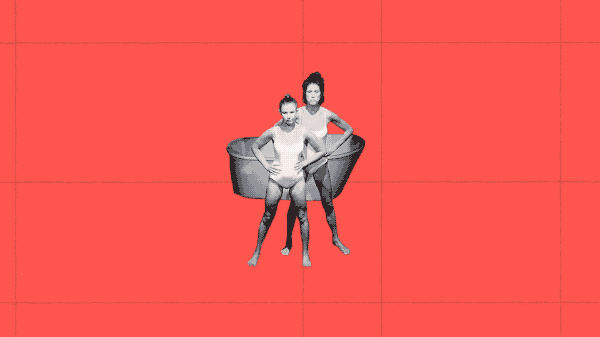Is it possible to make a living in the theatre industry where stability doesn't exist?
'We really have nothing,' laugh Amy Nostbakken and Norah Sadava, creators of the hit show Mouthpiece

Art, Death & Taxes unpacks the art world's greatest taboo: money. Nine acclaimed artists explore the economics of their practice, peeling back the curtain on all the work that goes into the work. Stream the full series now on CBC Gem.
"It is impressive how little money there is in theatre," says theatre artist Amy Nostbakken.
"And we talk about it a lot," adds Norah Sadava. "Like, how do we make this work? How do we provide ourselves with stability? But in this industry, that doesn't really exist."
The two women met while making their show Mouthpiece, which they break down the costs of for their episode of Art, Death & Taxes. "I heard that there was a woman in town in Toronto who had similar training to me, which is devised physical theatre. I got a $1000 grant, so I said, 'Do you wanna make $500 bucks in five days and just get in a room and play around with this idea I have?' Three years later we had a play."

Stream Norah Sadava and Amy Nostbakken's episode of Art, Death & Taxes now on CBC Gem
What's devised theatre? Sadava explains: "Devising is a way of working. We don't start with a script some dead white guy wrote 100 years ago. We start in a room with an idea and we make the show from scratch. So it's a much longer process. A lot of Canadian companies have three weeks to stage the play and then it's onstage. When you're devising, that's impossible. Our work just takes three years to make a show."
To produce the play, the two ended up in a cycle of grant applications and rejection. "Over those three years we applied to probably three to six grants a year and didn't get any — except for the very last minute of the third year we got $8000 from the Toronto Arts Council," says Nostabakken. "So that $8000 we spent to produce the show. That went to the salary of the sound designer, who was really underpaid. Our choreographer flew in from Israel — we paid for her flight but she worked for free. And it went to the purchase of a tub." The tub she refers to is a bathtub, the show's only piece of set design that they bought for $500 off Kijiji.
Alongside some bathing suits for their costumes, some flyers, and photography — "Our photographer we paid like nothing, $200," says Sadava — these were essentially the show's only costs.

But there was more beyond that that was needed to put on the show. Nostbakken explains: "Normally a show is a lot more than [$8000] — hundreds of thousands of dollars normally. The only reason we could do that is because we got accepted into this platform in Toronto run out of a theatre called Why Not. They came up with this concept called the RISER Project which gives fledgling losers a chance," they laugh. "They paid for the cost of the theatre and the cost of a lighting designer and PR and marketing. They rolled the dice on us and it was a smash hit. And they became our touring producers and we've been aligned ever since."
The duo is now at work on a new show called Universal Childcare, and the timing of their interview with Art, Death & Taxes ended up a bit ironic. "It's funny we're filming this program today," says Nostbakken, "because we just got denied a grant. We've created a script and the music, but because I'm four months pregnant, we want to shove in two of those devising sessions before the baby pops. We wouldn't normally do that, but it means we can't wait for the granting cycle. So we were counting on this other little bit of money. We're already under but we were like, 'If we just get this 10 grand we can make it work.' But we didn't get the 10 grand. So now we're about 20 grand in the hole."

"But we still really want to do it. We don't know what we're going to do. We stopped touring [Mouthpiece] so I could make a baby, so there's no other income coming in because of the nature of the show. Other shows you can do it — you just wear a different thing — but the show's so physical. It has like 29 slam-downs."
"The cost of childcare will increase our budget after she has a baby," says Sadava. And from Nostbakken's experience, she's found that there are very few theatre companies that even consider childcare.
"There is very little money in theatre in general. We have no buffer," Sadava says with a reflective seriousness mixed with humour about their difficult situation. "Even though we've been touring for four years, we've only made a profit at the very end. If we had been doing a thing for four years we should likely have a big buffer but we don't. We really have nothing." The two laugh.
"It's a really precarious industry."
Stream Art, Death & Taxes now on CBC Gem.
